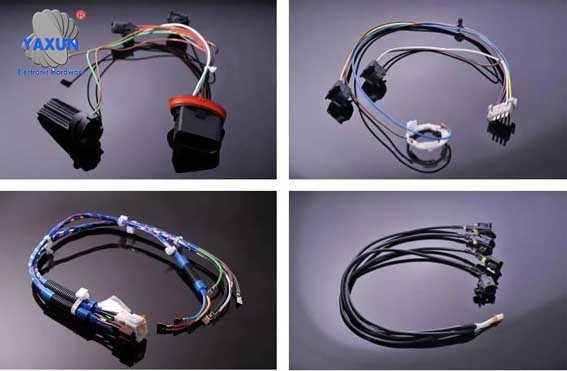Different from the wiring harness layout of other functions, car audio wiring has its own higher requirements. The wiring harness engineer in this article will take you to understand the basic knowledge of car audio wiring.
Since cars will generate interference of various frequencies while driving, which will adversely affect the listening environment of the car audio system, higher requirements are put forward for the installation and wiring of the car audio system.
1. Power cord wiring:
The current capacity value of the selected power cord should be equal to or greater than the value of the fuse connected to the power amplifier.
If sub-standard wires are used as power cords, AC noise will be generated and the sound quality will be seriously damaged. The power cord may become hot and burn.
When using a single power cord to separately power multiple amplifiers, the length of the wiring from the point of separation to each amplifier should be as equal as possible. When the power lines are bridged, a potential difference will appear between each power amplifier. This potential difference will cause AC noise, seriously damaging the sound quality. The picture below shows the car light wiring harness, heater, etc.
When the host is powered directly from the mains, noise is reduced and sound quality is improved. Thoroughly remove any dirt from the battery connectors and tighten the connectors tightly.
If the power connector is dirty or not tightened, there will be poor contact at the connector. The presence of blocking resistors will cause AC noise, seriously damaging the sound quality. Use sandpaper and a fine scraper to remove dirt from the joints, and apply butter at the same time. When routing wiring within a vehicle’s powertrain, avoid routing it near the generator and ignition, as generator noise and ignition noise can radiate into the power lines.
When replacing the factory-installed spark plugs and spark plug cables with high-performance types, the ignition spark will be stronger and ignition noise will be more likely to occur. The principles followed for laying out power cables and audio cables inside the car are the same.

Custom Car Audio Wiring (Putere, Ground, Semnal)
2. Grounding method:
Use fine sandpaper to remove the paint from the grounding point of the car body and secure the grounding wire tightly. If car paint remains between the car body and the ground terminal, it will cause contact resistance at the ground point. Similar to the dirty battery connectors mentioned above, contact resistance can lead to the generation of AC noise, which can seriously damage the sound quality. Concentrate the grounding of all audio equipment in the audio system at one point. If they are not grounded at one point, the potential difference between the components of the audio system will cause noise.
3. Selection of car audio wiring:
The smaller the resistance of the car audio wire, the less power is consumed on the wire, and the higher the efficiency of the system. Even if the wire is thick, a certain amount of power will be lost due to the speaker itself, without making the entire system 100% efficient.
The smaller the resistance of the wire, the greater the damping coefficient; the greater the damping coefficient, the greater the unnecessary vibration of the speaker. The larger (thicker) the cross-sectional area of the wire, the smaller the resistance, the larger the allowable current value of the wire, and the greater the allowable output power. When choosing a power fuse, the closer the fuse box of the main power cord is to the car battery connector, the better. The insurance value can be determined according to the following formula: insurance value = (sum of the total rated power of each power amplifier in the system ¡ 2) / average car power supply voltage.
4. Audio signal cable wiring:
Use insulating tape or heat shrink tubing to wrap the audio signal cable joints tightly to ensure insulation. When the joint comes into contact with the car body, noise can be generated. Keep audio signal lines as short as possible. The longer the audio signal line is, the more likely it is to be interfered by various frequency signals in the car. Note: If the length of the audio signal cable cannot be shortened, the extra long part should be folded instead of rolled up.
The audio signal cable should be routed at least 20cm away from the trip computer module circuit and the power cable of the amplifier. If the wiring is too close, the audio signal lines will pick up frequency interference noise. It is best to route the audio signal cables and power cables separately on both sides of the driver’s seat and passenger’s seat. Note that when wiring close to power lines and microcomputer circuits, the audio signal lines must be at least 20cm away from them. If audio signal cables and power cables need to cross each other, we recommend that they intersect at 90 degrees.
 English
English العربية
العربية Български
Български 中文(漢字)
中文(漢字) Čeština
Čeština Dansk
Dansk Eesti keel
Eesti keel Suomi
Suomi Français
Français Deutsch
Deutsch Ελληνικά
Ελληνικά עברית
עברית Magyar
Magyar Bahasa Indonesia
Bahasa Indonesia Italiano
Italiano 日本語
日本語 한국어
한국어 Latīna
Latīna Latviešu valoda
Latviešu valoda Lëtzebuergesch
Lëtzebuergesch Polski
Polski Português
Português Română
Română Русский
Русский Slovenščina
Slovenščina Español
Español Svenska
Svenska ภาษาไทย
ภาษาไทย Tiếng Việt
Tiếng Việt
